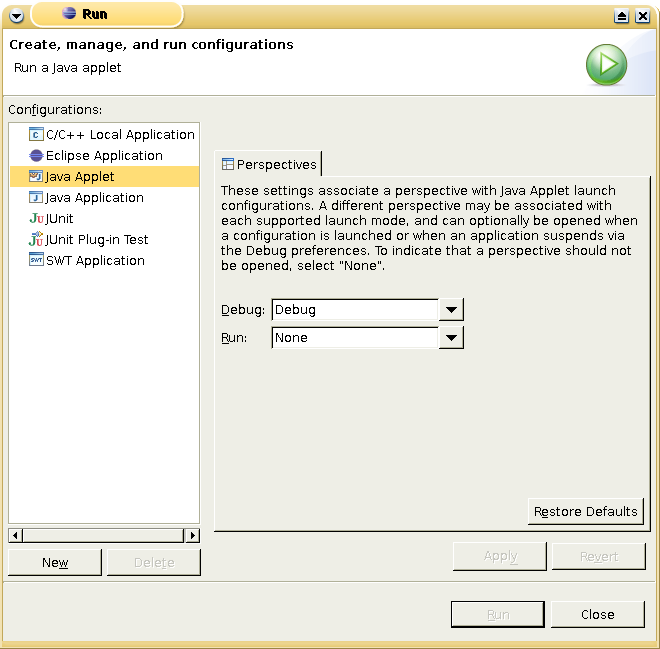
- #Java applet viewer eclipse how to
- #Java applet viewer eclipse archive
- #Java applet viewer eclipse software
- #Java applet viewer eclipse code
Using the same procedure that you followed in the last assignment, import this project into your Eclipse workspace.
#Java applet viewer eclipse archive
To run the applet, highlight BouncingSmileysApplet.java in the Package Explorer window and then choose Run from the Run menu Eclipse will know this file is an applet and fire it up with its applet viewer.Īs before, all these files have been collected into an Eclipse project and zipped into an archive this one is called You should also find that much of the code, perhaps with slight revision, from SmileyAnimation and BouncingDisplay, can be used in writing it. If done right, you will not have to modify any other class to make this applet function correctly. BouncingSmileysApplet.java sets the attributes of the display window and makes the smileys bounce around within it. We provide the outline of the applet class, BouncingSmileysApplet.java, which replaces (and performs the tasks equivalent to) the BoucingDisplay and BouncingFrame classes‐they are not appropriate because the applet window is used to display the graphics-and SmileyAnimaton-because that class animates smileys within a BouncingDisplay, which, with an applet, we do not have. the same as above, except the program runs as an applet launched via Eclipse's applet viewer. Part II - Convert This Application to an Applet Program Behavior and General Requirements We provide no documentation file for those classes-whatever methods you might need from these base classes will be documented in the classes that inherit them.) (Some classes we provide are needed only for purposes of inheritance. If an HTML file contains multiple applet tags, the applet viewer popsup multiple. For classes that you use as provided, we again provide a text file for each that describes its publicly available methods and constants. In Eclipse, you select Run -> Run as -> Java Applet from the menu.
#Java applet viewer eclipse software
(This happens a fair amount with real software systems: when a better way is found to accomplish the requirements of a class, that class is revised or rewritten - provided the resources spent doing so produces benefits worth the cost.) Technical DetailsĪgain we provide outlines of the classes you are to write (BouncingFrame and BouncingDisplay) with lots of comments and suggestions to guide you in meeting the public methods' requirements and with writing the private class items (methods, constants, fields) to support them. We trust that is no surprise in this assigment you are just swapping out provided classes for ones that you write.

#Java applet viewer eclipse code

English, French, Spanish, Dutch, German, Italian, Hebrew, Portuguese, Swedish, Danish, Norwegian, Hungarian, Russian, Latin and Czech.JLearnIt: a multilingual dictionary that helps you learn languages. Write once, run in any Java IDE (IntelliJ Platform IDE's, Eclipse, NetBeans) or as a standalone application Packaging is a standard Jar file and a html page with applet tag or a jnlp file Deployment is put the files on a webserver or on a shared network drive.Find in files: Find regular expression in specified files, Show file names, Show found line numbers, Show number of occurrence found.Characters: Character in specified font, Hexadecimal value based on specified character encoding, Decimal value, Character name, Character category.Properties: Java system properties, Java Swing UI Defaults, Computer environment properties.
#Java applet viewer eclipse how to
How to programmably change it to the middle of screen during the development I know when deploy in browser, we can't change the window from inside the applet since the html determines the location.



 0 kommentar(er)
0 kommentar(er)
